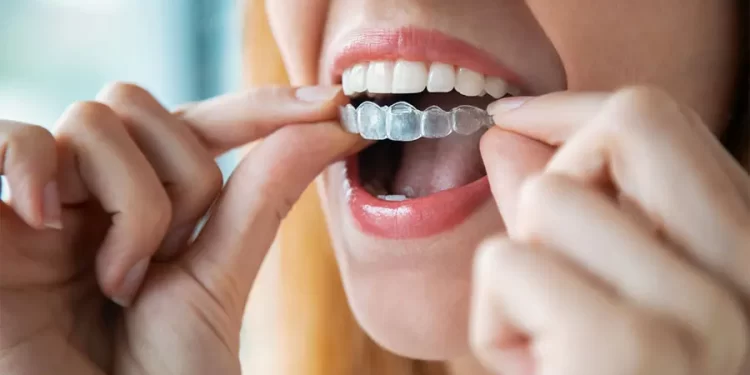Have you recently done an Invisalign treatment on your teeth to make them more presentable? If you did so, we would assume they aren’t working as you may have expected them to.
Otherwise, you wouldn’t have landed on our article, which deals with seven practical reasons the Invisalign treatment isn’t working for you. Worry not as we’re here to help you out with your problem.
We understand that having gaped or crooked teeth can be sometimes embarrassing. And failing to reshape them through a time-consuming treatment gets even more frustrating.
However, if you read this article, you’ll find some subtle yet telltale reasons that are withholding your teeth from getting their desired shapes.
Stay put as we’re taking you through this informative article.
About Invisalign
Invisalign is a modern orthodontic treatment that actually is a clear or transparent aligner with the teeth. This aligner fits perfectly with your teeth as it’s made based on the mold of a particular set of teeth.
Modern clinics and hospitals are very resourceful in treating broken or crooked teeth while ensuring bright and attractive smiles for patients. For instance, Marylebone Smile Clinic is one such institution where you can get the best Invisalign, gum lift, and teeth straightening treatments.
However, Invisalign is primarily more popular nowadays among those who don’t want to go with traditional braces. Invisalign, in contrast with braces, works fine for teenagers and adults alike.
How Does Invisalign Work?
You might have a clear idea about how Invisalign works if you’ve taken this treatment recently. If not, let us help you know it better.
The Invisalign aligners are prepared from plastics free from BPA (Bisphenol A; an industrial chemical). Once the aligners are placed in a set of teeth, they slowly move the teeth through slight pressure into the right position.
As you might already know that you’ve got to change the aligner every few weeks as per the doctor’s instruction, and the timeline of the treatment will vary depending on the individual issues. These issues might include the beautification goal, bite issues, etc.
The best part of Invisalign is that you don’t need to be extra-conscious about how your teeth will look when you smile since the aligners are nearly invisible. Apparently, it’s almost a win-win deal.
However, the problem might still be there as your teeth take too long to reposition, or the gape in your teeth isn’t blocked yet. Surprisingly, the root problem might often lie within your post-treatment care.
Let’s find out in the following seven practical reasons why your Invisalign may not be working.
Top 7 Practical Reasons The Invisalign Treatment Is Failing
Knowing about the actual reasons behind the Invisalign not working will put you on guard, and you’ll be able to maintain both your teeth and the aligner properly.
Let’s get on to the seven reasons below:
1. Your Body Is Unresponsive
It’s true that Invisalign treatment involves computer-aided modeling, which measures your teeth set to make the plastic aligner. However, it’s not possible for the computer to determine how your body will respond to the treatment.
It’s important because your teeth must support the aligner to work at its best within the required timeline. But if they’re not helping at all, the treatment might not be fruitful as expected.
2. You Changed The Aligners Too Soon
You mustn’t change the aligners without the permission of your orthodontist. There’s a standard time for switching to different aligners, and that varies from patient to patient.
As the expert orthodontists suggest, the next set of aligners must be fitting to your teeth’s current position and shape you’ve acquired through the previous aligner.
That is to say, you mustn’t opt for the next aligner if there’s a noticeable gap between one of your teeth and the aligner. This tells you that your tooth was unresponsive, and you need some more time for it to reposition.
3. You Aren’t Regularly Wearing Your Aligners
Invisalign aligners are moveable, and you can eat, brush, and floss after removing them from your teeth. This sounds like easy maintenance, but you mustn’t be careless about wearing it.
Many make the mistake of not wearing the aligner for a long time after brushing or flossing. This increases the optimum time required for the aligner to shape and position the teeth.
Make sure, you were the Invisalign aligner for at least 20-22 hours a day. If you’re wearing it any time less than that, chances are that the treatment won’t work on you.
4. You’re Ignoring Your Chewies
Your orthodontist must’ve suggested you chew on recommended chewies for exerting the necessary pressure on your teeth. You might know that these chewies can help you in gaining the optimum results within the desired timeline.
However, if you’re missing out on your chewies, it’s surely depriving your misshapen teeth of the required pressure, hence, a longer time for repositioning.
Munching on the special chewies recommended by the orthodontist makes sure that the Invisalign trays are correctly set on your teeth.
5. Your Aligners Are No Longer Working
When you were given by your orthodontists a set of Invisalign aligners, each of them had a timeline set to reposition your teeth to a certain degree. That’s how you knew when to switch to the next aligner as scheduled.
However, if you’ve worn your aligner for longer than it’s supposed to be, it will not only stop working, but it may even deteriorate your teeth’ position and shape.
6. You Might Have Cavities Or Other Dental Issues
It’s essential to get your oral health checked before you get the Invisalign treatment. Your dentist will check your teeth’ condition to determine whether you qualify for the treatment or not.
However, if you skip the examination of your dental health and opt for the Invisalign aligners, there is a high chance that you’ll have issues. The underlying teeth problems like cavities or other periodontal diseases may lead to tooth decay if not taken care of before Invisalign treatment is administered.
You must be responsible enough to maintain your dental health and the Invisalign as long as it takes. In this case, getting your dental health checked is the first thing you must start with, followed by preventing periodontal diseases and other dental issues.
7. You Aren’t Maintaining Your Aligners
It’s compulsory to take care of the Invisalign aligner when you’re taking it off your teeth. If you’ve been letting it lie around somewhere unprotected, it might be dented or warped.
The same thing may happen if someone tries to wash it with hot water. The aligner might lose its original shape and wearing it at a later stage won’t let the tray fit your teeth as before. Simply, the aligner will stop tracking.
So, clean your aligner as recommended to keep your teeth free from germs and diseases.
Remedies to Follow If Your Invisalign Isn’t Working?
Apart from pointing out the reasons why your Invisalign treatment isn’t working, it’s important to know what you can do to make things right. After all, you can’t let some ignorance let your treatment go wasted.
So, read below to know some corrective steps about reconciling your Invisalign treatment:
- Further Treatment: If your current treatment isn’t working at all and you’re seeing a noticeable gap between two teeth, it may be time for additional treatment.
You may see another expert orthodontist, so he can recommend aligner refinements. This might add up to your current treatment schedule, meaning you’ll need more time to get your teeth in shape.
- Backtracking: You might not like it, but since there have been some oddities in your current treatment due to a non-compliant aligner, you better ask your orthodontist about a backtracking treatment.
A backtracking treatment essentially means that you have to wear your previous Invisalign aligner for a longer period than what was originally scheduled. This may solve the incisal gaps, ill-fitting problems, incomplete teeth movements, etc.
- Maintenance: As mentioned earlier, the lack of maintenance of your aligner may damage or alter it while depriving your teeth of the required fitting. Cleaning aligners in hot water, smoking, drinking sugary or alcoholic beverages, etc., are a few of the non-compliant activities while wearing aligners.
Hence, it’s best for you to restrain smoking and drinking habits while cleaning the aligners as recommended.
- Revised Treatment: Your Invisalign treatment may trip in the middle of the schedule due to many natural developments in your oral health system. If you observe that your aligners are working oddly, you might need to consult your orthodontist soon for a revised treatment.
If the orthodontist sees it fitting, he’ll take a new impression of your teeth to start a revised treatment.
- Different Orthodontists: If you feel that your orthodontist is failing to provide you with the optimum advice and additional support, it may be time to see a new orthodontist.
Look for someone whom your familiar people may recommend, and additionally, check whether he or she’s a ‘Diamond Plus’ certified orthodontist or not. A diamond plus orthodontist or Invisalign provider is one who has successfully treated over two hundred patients within six months.
Final Summary
Invisalign treatment is an advanced computerized treatment that can bring back your smile with more confidence and beauty. However, if you’ve been facing certain problems, you must check with the seven reasons we’ve just mentioned above.
It goes without saying that you mustn’t try anything off the book on your own to put your teeth back into shape. Ignoring your orthodontist’s advice and recommended maintenance of the Invisalign aligners might pose a great threat to your dental health.
Lastly, don’t hesitate to ask your orthodontist for help when you notice that the treatment they’ve administered isn’t quite working out for you as desired.


























